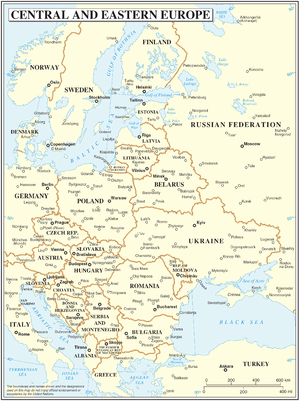- Central Eastern Europe
-
MOEL ist die Abkürzung für mittel- und osteuropäische Länder – MOE, Mittel-/Osteuropa. Gleichbedeutend wird auch der Begriff mittel- und osteuropäische Staaten (MOES) gebraucht. Der englische Ausdruck lautet CEE für engl. Central and Eastern Europe.
Welche Länder tatsächlich zu den Mittel- und Osteuropäischen Ländern gehören, ist unscharf abgegrenzt. Im engeren Sinn wird der Begriff für jene Länder gebraucht, die im Rahmen der EU-Erweiterung 2004 und 2007 in die Europäische Union aufgenommen wurden (EU-12). Die ebenfalls unscharf abgegrenzte Großregion Ostmitteleuropa ist ein Teil der MOEL.
Inhaltsverzeichnis
Begriffsgeschichte
Ostblock/Osteuropa
Bis 1989 wurde in Westeuropa meist der Begriff Ostblock verwendet, um jene Staaten Mittel- und Osteuropas zu kennzeichnen, die im Einflussgebiet der Sowjetunion lagen. Nach den friedlichen Umwälzungen von 1989/90 wurde allerdings ein neuer Begriff für die Staaten dieser Region gesucht. Die ursprünglich ebenfalls weit verbreitete Bezeichnung Osteuropa ist im geographischen und historischen Sinne nicht korrekt. Mit der Bezeichnung Mittel- und osteuropäische Länder sollte auch signalisiert werden, dass die meisten dieser Staaten lange Zeit zum Kern der europäischen Kultur zählten.
Mittel-/Osteuropa, Mittel- und Osteuropa
Auch der Begriff Mittel-/Osteuropa, Mittel- und Osteuropa (MOE) findet breite Anwendung in Kontexten, wie der Zusammenarbeit der Regierungen und ihrer Organisationen, der Entwicklungsorganisationen und kommerzieller Unternehmen.
MOEL-Staaten
im engeren Sinn
Die zu den MOEL zählenden Staaten sind:
- Estland, Lettland und Litauen (die baltischen Staaten, alle EU-Beitritt 2004)
- Ungarn, Tschechien, die Slowakei und Polen (die Visegrád-Gruppe, Beitritt 2004)
- Von den Nachfolgestaaten Jugoslawiens werden Slowenien (Beitritt 2004) und Kroatien zu den MOEL gezählt (Kroatien ist kein EU-Mitglied, zählt also nicht zu EU-12)
- Darüber hinaus werden meist auch die eigentlich zu Südosteuropa gehörenden Staaten Bulgarien und Rumänien (Beitritt 2007) zu den MOEL gezählt.
Nicht zu den MOEL im engeren Sinn zählen üblicherweise:
- jene Länder Mitteleuropas, die vor 1989 zur westlichen Einflusssphäre zählten
- die vormals zur Deutschen Demokratischen Republik gehörigen ostdeutschen Bundesländer Deutschlands
- die Nachfolgestaaten der Sowjetunion in Europa – mit Ausnahme der baltischen Staaten
- die Nachfolgestaaten Jugoslawiens mit Ausnahme von Slowenien und Kroatien
- Albanien
- die ebenfalls in der EU-Erweiterung 2004 aufgenommenen Staaten Malta und Zypern
im erweiterten Sinn
Gelegentlich wird der Begriff „Mittel- und Osteuropäische Staaten“ auch für das gesamte Kontinentaleuropa östlich der EU-Grenzen von vor der EU-Osterweiterung verwendet.
Zu den MOEL-Staaten im erweiterten Sinn zählen:
- in Zentraleuropa
- in Südosteuropa
- das Baltikum
- im restlichen Osteuropa
- Ukraine
- Weißrussland
- Russland
- sowie Kasachstan an den Ostgrenzen Europas
Die MOEL im erweiterten Sinn kommen auf eine Gesamtfläche von circa 18.771.000 km² (davon allein Russland rund 17 Mio. km²) und eine Einwohnerzahl von 313,5 Millionen (davon Russland 144 Mio.).
Wikimedia Foundation.

